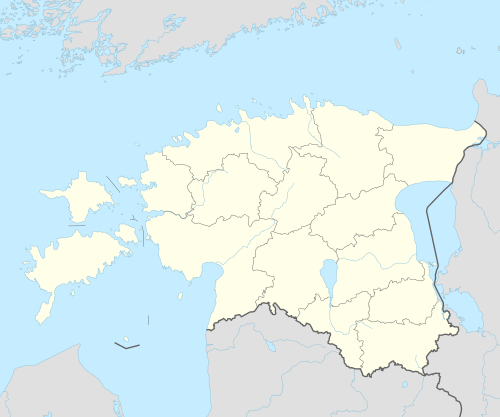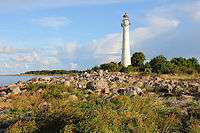Kihnu
Kihnu (Swedish: Kynö) is an island in the Baltic Sea. With an area of 16.4 km2 (6.3 sq mi) it is the largest island in the Gulf of Riga[2] and the seventh largest island of Estonia. The length of the island is 7 km (4.3 mi) and width 3.3 km (2.1 mi), the highest point is at 8.9 metres (29.2 ft) above sea level.
Kihnu Kihnu Kynö | |
|---|---|
Island | |
Gulf of Riga, with Kihnu and other islands | |
 Kihnu Location of Kihnu within Estonia | |
| Coordinates: 58°07′48″N 23°59′24″E | |
| Country | |
| Region | Pärnu County |
| Municipality | Kihnu Parish |
| Area | |
| • Total | 16.38 km2 (6.32 sq mi) |
| Elevation | 29.6 m (97.1 ft) |
| Population (2013) | |
| • Total | 490 |
| • Density | 30/km2 (77/sq mi) |
| Time zone | UTC+2 (EET) |
| • Summer (DST) | UTC+3 (EEST) |
| Postal codes | 88005 |
The island belongs to the Pärnu County of Estonia. Together with neighbouring islands it forms Kihnu Parish, one of the smallest municipalities of the country with an area of 16.8 km2 (6.5 sq mi).
604 people live on Kihnu as of 2007 of whom 69 are primary school pupils. There are four villages: Lemsi, Linaküla, Rootsiküla and Sääre. One can reach Kihnu by plane from Pärnu (15 minutes) or ferry from either Pärnu (3 hours) or Manilaid (1 hour), and when the sea is frozen in winter it is possible to drive to the island over the ice.
Of the estimated 300 year-round residents of Kihnu, the vast majority are women. It is sometimes called the “Isle of Women”.[3]
Culture
Kihnu's mittens, troi, "ülalistmine" and striped skirts are famous in many countries, especially among craftsmen and scientists.
UNESCO proclaimed Kihnu's cultural space and traditions as a Masterpiece of the Oral and Intangible Heritage of Humanity on November 7, 2003. The Baltic Sea islands of Manija and Kihnu are home to a small group of traditional people. For many years, the men of Kihnu have been frequently gone to sea while the women ran the island and became the guardians of the island's cultural heritage, which includes handicrafts, dances, games and music. Music is an especially important part of the island's traditions, and accompanies handicrafts, religious feasts and other celebrations. Ancient runo-styled songs are also important, as are traditional clothings adorned with decorations and bright colours that symbolize ancient legends and poems. The people of Kihnu speak a dialect of Estonian which is sometimes considered to be a distinct language and contains many elements from Swedish.
Geography and climate
The island has a sandy interior and a rocky coast made up of more than fifty islets which make up an important nesting ground for birds. Along the dunes, beach ridges and sands of the eastern part the island reaches its maximum height of 29.6 m above sea level.[1]
| Climate data for Kihnu (1981–2010) | |||||||||||||
|---|---|---|---|---|---|---|---|---|---|---|---|---|---|
| Month | Jan | Feb | Mar | Apr | May | Jun | Jul | Aug | Sep | Oct | Nov | Dec | Year |
| Record high °C (°F) | 8.1 (46.6) |
6.3 (43.3) |
15.0 (59.0) |
23.9 (75.0) |
29.2 (84.6) |
30.6 (87.1) |
31.8 (89.2) |
29.5 (85.1) |
23.3 (73.9) |
17.5 (63.5) |
12.0 (53.6) |
9.0 (48.2) |
31.8 (89.2) |
| Average high °C (°F) | −0.3 (31.5) |
−1.5 (29.3) |
1.3 (34.3) |
7.1 (44.8) |
13.7 (56.7) |
17.6 (63.7) |
20.7 (69.3) |
20.1 (68.2) |
15.3 (59.5) |
10.2 (50.4) |
4.7 (40.5) |
1.6 (34.9) |
9.2 (48.6) |
| Daily mean °C (°F) | −2.1 (28.2) |
−3.5 (25.7) |
−1.0 (30.2) |
3.9 (39.0) |
10.1 (50.2) |
14.5 (58.1) |
17.9 (64.2) |
17.5 (63.5) |
13.1 (55.6) |
8.3 (46.9) |
3.2 (37.8) |
−0.1 (31.8) |
6.8 (44.2) |
| Average low °C (°F) | −4.1 (24.6) |
−5.6 (21.9) |
−3.2 (26.2) |
1.6 (34.9) |
7.5 (45.5) |
12.0 (53.6) |
15.4 (59.7) |
15.2 (59.4) |
10.9 (51.6) |
6.6 (43.9) |
1.5 (34.7) |
−2 (28) |
4.6 (40.3) |
| Record low °C (°F) | −32.4 (−26.3) |
−30.8 (−23.4) |
−20.6 (−5.1) |
−8.5 (16.7) |
−1 (30) |
3.2 (37.8) |
8.0 (46.4) |
7.0 (44.6) |
0.6 (33.1) |
−5.4 (22.3) |
−14.5 (5.9) |
−19.6 (−3.3) |
−32.4 (−26.3) |
| Average precipitation mm (inches) | 37 (1.5) |
29 (1.1) |
30 (1.2) |
30 (1.2) |
34 (1.3) |
58 (2.3) |
65 (2.6) |
66 (2.6) |
62 (2.4) |
64 (2.5) |
58 (2.3) |
45 (1.8) |
578 (22.8) |
| Average relative humidity (%) | 87 | 87 | 86 | 81 | 77 | 80 | 80 | 80 | 81 | 83 | 86 | 87 | 83 |
| Source: Estonian Weather Service[4][5][6] | |||||||||||||
Images of Kihnu

Church 
An inn 
Seashore 
Museum Village road Garden A view of the coastline Young girls in both modern and traditional dress returning from school. Pine forest 
Cemetery An adult grey seal on drift ice just off of the Kihnu coast.
See also
References
- "The islands in the Väinameri Sea and the Gulf of Riga". Estonica. Eesti Instituut. September 28, 2012. Retrieved February 20, 2018.
- C.Michael Hogan. 2011. Gulf of Riga. Encyclopedia of Earth. Eds. P.Saundry & C.J.Cleveland. National Council for Science and the Environment. Washington DC.]
- Richard, Hillary (October 2, 2019). "Welcome to Estonia's Isle of Women" – via NYTimes.com.
- "Climate normals-Temperature". Estonian Weather Service. Retrieved 27 September 2016.
- "Climate normals-Precipitation". Estonian Weather Service. Retrieved 27 September 2016.
- "Climate normals-Humidity". Estonian Weather Service. Retrieved 27 September 2016.
External links
| Wikimedia Commons has media related to Kihnu. |
| Wikivoyage has a travel guide for Kihnu. |
